Temescal Associates and its Founder, Sam Piha, have authored and worked with others to create a number of resources for practitioners and organizational leaders. To view a comprehensive listing of professional development resources produced by Temescal Associates and The How Kids Learn Foundation, click here.
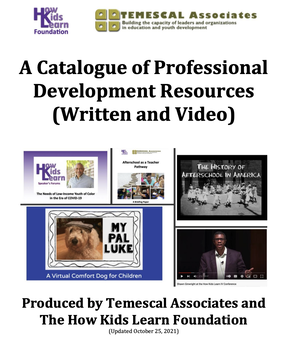
A Catalogue of Professional Development Resources (Written and Video)
A comprehensive listing of professional development resources produced by Temescal Associates and The How Kids Learn Foundation.
VIEW AND DOWNLOAD HERE.
A comprehensive listing of professional development resources produced by Temescal Associates and The How Kids Learn Foundation.
VIEW AND DOWNLOAD HERE.

Self-Care for Youth Workers
Those in the helping professions, including youth workers, are vulnerable to stress, burnout, and professional impairment.
This paper examines the role of self-care in the promotion of well-being among youth worker practitioners and specific domains of self-care practice, including awareness, work/life balance, flexibility, physical health, social support, and spirituality. It underscores the importance of taking a proactive approach to self-care.
VIEW AND DOWNLOAD HERE.
Those in the helping professions, including youth workers, are vulnerable to stress, burnout, and professional impairment.
This paper examines the role of self-care in the promotion of well-being among youth worker practitioners and specific domains of self-care practice, including awareness, work/life balance, flexibility, physical health, social support, and spirituality. It underscores the importance of taking a proactive approach to self-care.
VIEW AND DOWNLOAD HERE.

NEW! How Afterschool Programs Can Promote Civic Engagement and the Youth Vote in 2024
The 2024 election offers a number of opportunities to engage older youth. But these opportunities require input from youth, organizing and planning- so start program planning early. Some of the contents of this paper are drawn from existing writings on youth engagement in elections. This paper is designed to raise understanding and awareness of the impact of promoting civic engagement in elections in afterschool programs. This paper also provides resources for afterschool and organizational leaders. We recommend that program leaders share this paper with organizational leaders (school leaders and staff, supervisors at the parent non-profit org, etc.) and program staff as they consider the best ways to incorporate election civic engagement into their program.
VIEW AND DOWNLOAD HERE.
The 2024 election offers a number of opportunities to engage older youth. But these opportunities require input from youth, organizing and planning- so start program planning early. Some of the contents of this paper are drawn from existing writings on youth engagement in elections. This paper is designed to raise understanding and awareness of the impact of promoting civic engagement in elections in afterschool programs. This paper also provides resources for afterschool and organizational leaders. We recommend that program leaders share this paper with organizational leaders (school leaders and staff, supervisors at the parent non-profit org, etc.) and program staff as they consider the best ways to incorporate election civic engagement into their program.
VIEW AND DOWNLOAD HERE.
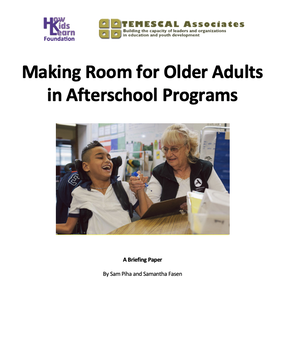
Making Room for Older Adults in Afterschool Programs
A solution to the afterschool program worker shortage AND the need to diversify staff is bringing on older adults or “wisdom” workers, whether they are employees or volunteers. This paper is designed to raise understanding and awareness of the impact of hiring older adults to work in afterschool programs and how afterschool programs can utilize this talent pool. It reviews the benefits of an age- diverse staff, provide program examples and tips on recruiting, train and utilize “wisdom” workers in administrative and direct service positions. We also share resources for afterschool leaders. We recommend this paper to program and organizational leaders and program staff as they consider the best ways to recruit and incorporate multigenerational staff into their program.
VIEW AND DOWNLOAD HERE.
A solution to the afterschool program worker shortage AND the need to diversify staff is bringing on older adults or “wisdom” workers, whether they are employees or volunteers. This paper is designed to raise understanding and awareness of the impact of hiring older adults to work in afterschool programs and how afterschool programs can utilize this talent pool. It reviews the benefits of an age- diverse staff, provide program examples and tips on recruiting, train and utilize “wisdom” workers in administrative and direct service positions. We also share resources for afterschool leaders. We recommend this paper to program and organizational leaders and program staff as they consider the best ways to recruit and incorporate multigenerational staff into their program.
VIEW AND DOWNLOAD HERE.

Gardening in Afterschool Programs
Research tells us that young people’s connection to the outdoors and nature contributes to their healthy development. This connection can be promoted by involving youth in gardening. And afterschool programs are particularly well positioned to offer gardening activities.
The contents of this paper are drawn from existing writings on gardening with youth. This paper is designed to raise understanding and awareness of the impact of gardening on youth and how afterschool programs can utilize this activity. It also provides resources for afterschool and organizational leaders. We recommend that program leaders share this paper with organizational leaders (school leaders and staff, supervisors at the parent non-profit org, etc.) and program staff as they consider the best ways to incorporate gardening into their program.
VIEW AND DOWNLOAD HERE.
Research tells us that young people’s connection to the outdoors and nature contributes to their healthy development. This connection can be promoted by involving youth in gardening. And afterschool programs are particularly well positioned to offer gardening activities.
The contents of this paper are drawn from existing writings on gardening with youth. This paper is designed to raise understanding and awareness of the impact of gardening on youth and how afterschool programs can utilize this activity. It also provides resources for afterschool and organizational leaders. We recommend that program leaders share this paper with organizational leaders (school leaders and staff, supervisors at the parent non-profit org, etc.) and program staff as they consider the best ways to incorporate gardening into their program.
VIEW AND DOWNLOAD HERE.
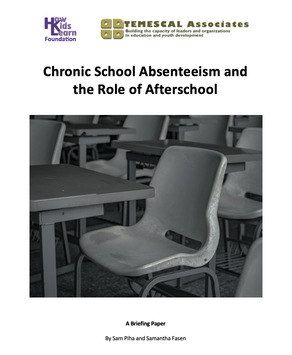
Chronic School Absenteeism and the Role of Afterschool
We know that school attendance is key to student success. Students who attend school regularly are more likely to master academic content, get good grades, feel connected to their community, develop healthy habits, and ultimately graduate from high school. The COVID pandemic resulted in a spike in school absenteeism. Before the pandemic, about 8 million U.S. students were considered chronically absent, according to the research group Attendance Works. By spring 2022, that number had doubled to around 16 million.
This paper is designed to raise understanding and awareness of the impact of chronic absenteeism and how afterschool programs can positively impact this crisis. It also provides resources for afterschool and organizational leaders.
VIEW AND DOWNLOAD HERE.
We know that school attendance is key to student success. Students who attend school regularly are more likely to master academic content, get good grades, feel connected to their community, develop healthy habits, and ultimately graduate from high school. The COVID pandemic resulted in a spike in school absenteeism. Before the pandemic, about 8 million U.S. students were considered chronically absent, according to the research group Attendance Works. By spring 2022, that number had doubled to around 16 million.
This paper is designed to raise understanding and awareness of the impact of chronic absenteeism and how afterschool programs can positively impact this crisis. It also provides resources for afterschool and organizational leaders.
VIEW AND DOWNLOAD HERE.
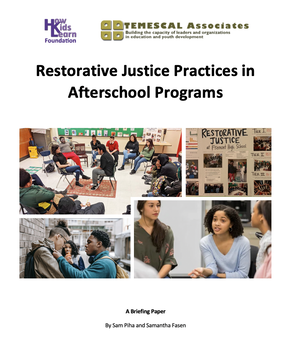
Restorative Justice Practices in Afterschool Programs
Restorative justice is a values-based practice. It creates a safe environment and builds trusting relationships, which are critical features of quality afterschool programs. These are the foundation on which afterschool programs can integrate restorative justice practices.
This paper is designed to raise understanding and awareness of restorative justice practices and identify ways afterschool leaders can integrate them. We recommend that program leaders share this paper with organizational leaders and program staff and consider the best ways to respond to personal harm and conflicts among youth participants.
VIEW AND DOWNLOAD HERE.
Restorative justice is a values-based practice. It creates a safe environment and builds trusting relationships, which are critical features of quality afterschool programs. These are the foundation on which afterschool programs can integrate restorative justice practices.
This paper is designed to raise understanding and awareness of restorative justice practices and identify ways afterschool leaders can integrate them. We recommend that program leaders share this paper with organizational leaders and program staff and consider the best ways to respond to personal harm and conflicts among youth participants.
VIEW AND DOWNLOAD HERE.

Learning About Artificial Intelligence (AI) in Afterschool
Almost every day there is a piece in the news about the opportunities and dangers of Artificial Intelligence (AI). Many young people, even those who are very tech savvy, know little about this topic. Adults, including those in afterschool programs, know even less. Yet, AI is being used by companies more and more. We believe that youth need to understand more about AI. Afterschool is a perfect place to do this, but are afterschool leaders equipped for this?
This paper is designed to introduce AI, raise understanding and awareness of artificial intelligence and identify ways afterschool leaders can educate their program participants. And if appropriate, offer hands-on experiences allowing youth to engage in AI projects.
VIEW AND DOWNLOAD HERE.
Almost every day there is a piece in the news about the opportunities and dangers of Artificial Intelligence (AI). Many young people, even those who are very tech savvy, know little about this topic. Adults, including those in afterschool programs, know even less. Yet, AI is being used by companies more and more. We believe that youth need to understand more about AI. Afterschool is a perfect place to do this, but are afterschool leaders equipped for this?
This paper is designed to introduce AI, raise understanding and awareness of artificial intelligence and identify ways afterschool leaders can educate their program participants. And if appropriate, offer hands-on experiences allowing youth to engage in AI projects.
VIEW AND DOWNLOAD HERE.

Promoting Financial Literacy for Youth in Afterschool Programs
Every child and adolescent should be exposed to financial literacy education. One would think that schools are the obvious place for this, which would also address the financial literacy gap. However few states require this as part of their requirements for high school graduation. And because of the concern around COVID learning loss, low test scores in math and reading, and other pressures, many schools are not in a position to add financial literacy to their curriculum.
This paper is designed to raise understanding and awareness of the need for youth financial literacy and identify ways afterschool leaders can address these issues. We recommend that program leaders share this paper with organizational leaders and program staff and consider the best ways to respond to this need.
VIEW AND DOWNLOAD HERE.
Every child and adolescent should be exposed to financial literacy education. One would think that schools are the obvious place for this, which would also address the financial literacy gap. However few states require this as part of their requirements for high school graduation. And because of the concern around COVID learning loss, low test scores in math and reading, and other pressures, many schools are not in a position to add financial literacy to their curriculum.
This paper is designed to raise understanding and awareness of the need for youth financial literacy and identify ways afterschool leaders can address these issues. We recommend that program leaders share this paper with organizational leaders and program staff and consider the best ways to respond to this need.
VIEW AND DOWNLOAD HERE.
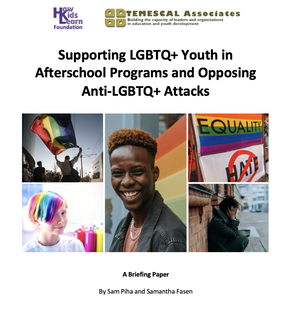
Supporting LGBTQ+ Youth in Afterschool Programs and Opposing Anti-LGBTQ+ Attacks
The recent attacks on LGBTQ+ youth in political rhetoric and state house legislation are targeting LGBTQ+ young people, according to the Trevor Project, which ranges from “censoring LGBTQ-related curriculums and books, banning transgender student-athletes from participating in sports that match their gender identity, to criminalizing doctors and families who support youth with transgender medical care.”
This paper is designed to raise understanding and awareness of the anti-LGBTQ climate and identify ways afterschool leaders can address these issues and support LGBTQ+ youth. We recommend that program leaders share this paper with organizational leaders and program staff and consider the best ways to respond to this.
VIEW AND DOWNLOAD HERE.
The recent attacks on LGBTQ+ youth in political rhetoric and state house legislation are targeting LGBTQ+ young people, according to the Trevor Project, which ranges from “censoring LGBTQ-related curriculums and books, banning transgender student-athletes from participating in sports that match their gender identity, to criminalizing doctors and families who support youth with transgender medical care.”
This paper is designed to raise understanding and awareness of the anti-LGBTQ climate and identify ways afterschool leaders can address these issues and support LGBTQ+ youth. We recommend that program leaders share this paper with organizational leaders and program staff and consider the best ways to respond to this.
VIEW AND DOWNLOAD HERE.
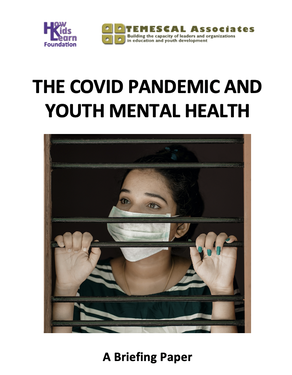
The COVID Pandemic and Youth Mental Health
Young people have proven to be especially vulnerable to mental health issues related to the COVID-19 pandemic. School closures, having to learn remotely, and isolating from friends due to physical distancing have been sources of stress and loneliness. While COVID learning loss in math and reading are of high concern, research about how students are doing mentally and emotionally since the coronavirus pandemic began indicates they are not doing well.
In this briefing paper we examine the facts of how the pandemic has impacted young people’s mental health, what we can do in afterschool, the radical power of kindness and joy in afterschool programs, current youth-led efforts to address the mental health crisis, promoting the mental health and self-care of afterschool workers and offer additional resources if readers want to learn more.
VIEW AND DOWNLOAD HERE.
Young people have proven to be especially vulnerable to mental health issues related to the COVID-19 pandemic. School closures, having to learn remotely, and isolating from friends due to physical distancing have been sources of stress and loneliness. While COVID learning loss in math and reading are of high concern, research about how students are doing mentally and emotionally since the coronavirus pandemic began indicates they are not doing well.
In this briefing paper we examine the facts of how the pandemic has impacted young people’s mental health, what we can do in afterschool, the radical power of kindness and joy in afterschool programs, current youth-led efforts to address the mental health crisis, promoting the mental health and self-care of afterschool workers and offer additional resources if readers want to learn more.
VIEW AND DOWNLOAD HERE.
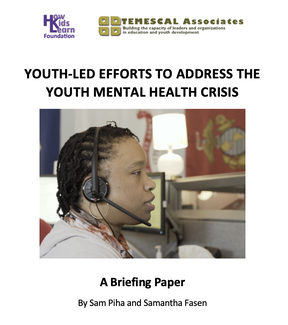
Youth-Led Efforts to Address the Youth Mental Health Crisis
The concerns of youth declining mental health are not new. Nor is the shortage of mental health professional in our schools and communities. Both were issues before the pandemic and as a result of the pandemic these issues are of greater concern.
In this briefing paper we examine reasons to involve youth directly in efforts to address
youth mental health, current youth-led efforts dedicated to improving youth mental health, interview two youth leaders working to improve the mental health of their peers, and offer resources if readers want to learn more.
VIEW AND DOWNLOAD HERE.
The concerns of youth declining mental health are not new. Nor is the shortage of mental health professional in our schools and communities. Both were issues before the pandemic and as a result of the pandemic these issues are of greater concern.
In this briefing paper we examine reasons to involve youth directly in efforts to address
youth mental health, current youth-led efforts dedicated to improving youth mental health, interview two youth leaders working to improve the mental health of their peers, and offer resources if readers want to learn more.
VIEW AND DOWNLOAD HERE.
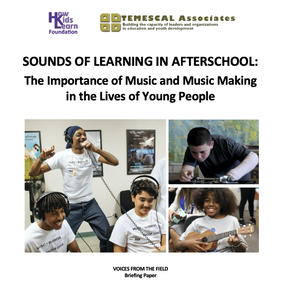
SOUNDS OF LEARNING IN AFTERSCHOOL: The Importance of Music and Music Making in the Lives of Young People
Sounds Of Learning in Afterschool seeks to make a compelling case for the incorporation of opportunities for youth to participate in music programs after school, particularly ones that are most relevant to the interest of youth. This paper offers important terms and definitions, as well as comments from afterschool practitioners, youth and researchers. It goes on to profile afterschool programs across the country that have incorporated music and music making into their programs (teaching how to play an instrument, DJ skills, making beats, music writing and recording and more).
VIEW AND DOWNLOAD HERE.
Sounds Of Learning in Afterschool seeks to make a compelling case for the incorporation of opportunities for youth to participate in music programs after school, particularly ones that are most relevant to the interest of youth. This paper offers important terms and definitions, as well as comments from afterschool practitioners, youth and researchers. It goes on to profile afterschool programs across the country that have incorporated music and music making into their programs (teaching how to play an instrument, DJ skills, making beats, music writing and recording and more).
VIEW AND DOWNLOAD HERE.
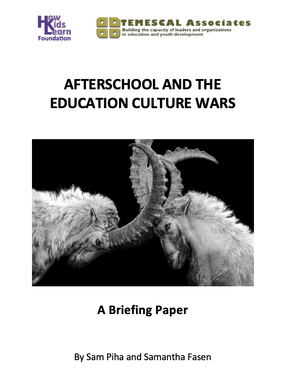
Afterschool and the Education Culture Wars
We live in a political climate where differences are not explored, they are weaponized. In recent months schools and educators have been attacked under the guise of critical race theory, parent rights and the call to ban certain books. While afterschool programs have not been attacked directly, there are certain core values and program initiatives that have come under scrutiny. They include equity, identity (LGBTQ+ and racial), mindfulness, growth mindsets, grit and social emotional learning (SEL).
This paper presents important terms and definitions, examines the history of bipartisan support for afterschool and the recent uptick in criticism of afterschool’s core concepts, and provides tips and resources to avoid entanglement in education culture wars.
VIEW AND DOWNLOAD HERE.
We live in a political climate where differences are not explored, they are weaponized. In recent months schools and educators have been attacked under the guise of critical race theory, parent rights and the call to ban certain books. While afterschool programs have not been attacked directly, there are certain core values and program initiatives that have come under scrutiny. They include equity, identity (LGBTQ+ and racial), mindfulness, growth mindsets, grit and social emotional learning (SEL).
This paper presents important terms and definitions, examines the history of bipartisan support for afterschool and the recent uptick in criticism of afterschool’s core concepts, and provides tips and resources to avoid entanglement in education culture wars.
VIEW AND DOWNLOAD HERE.
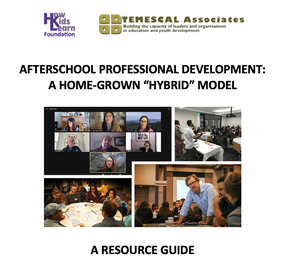
Afterschool Professional Development: A Home-Grown "Hybrid" Model
In this guide (39 pages) we identify “Basics” professional development resources with links for free, easy access (recorded videos, briefing papers, blogs, etc.). These were developed by Temescal Associates and The How Kids Learn Foundation (HKLF). Also included are worksheets, discussion guides and other resources to support programs in leading their own professional development and reflection activities.
VIEW AND DOWNLOAD HERE.
In this guide (39 pages) we identify “Basics” professional development resources with links for free, easy access (recorded videos, briefing papers, blogs, etc.). These were developed by Temescal Associates and The How Kids Learn Foundation (HKLF). Also included are worksheets, discussion guides and other resources to support programs in leading their own professional development and reflection activities.
VIEW AND DOWNLOAD HERE.
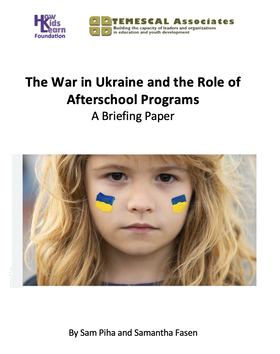
The War in Ukraine and the Role of Afterschool Programs: A Briefing Paper
The coverage of the Russian invasion of Ukraine has dominated TV and social media, resulting in horrific images of buildings exploding in fire, families bloodied and injured from missile attacks, and fearful children and parents attempting to flee to safety. This is being viewed by children and teenagers as well as adults.
Foundational to every afterschool program is promoting a sense of emotional safety and reliable information. We believe this includes how to talk to kids about war and how to decipher real vs. fake news. In this paper we offer some thoughts and resources to assist afterschool leaders.
VIEW AND DOWNLOAD HERE.
TO PURCHASE SPIRAL-BOUND HARD COPIES OF THE GUIDE, PLEASE CONTACT US.
The coverage of the Russian invasion of Ukraine has dominated TV and social media, resulting in horrific images of buildings exploding in fire, families bloodied and injured from missile attacks, and fearful children and parents attempting to flee to safety. This is being viewed by children and teenagers as well as adults.
Foundational to every afterschool program is promoting a sense of emotional safety and reliable information. We believe this includes how to talk to kids about war and how to decipher real vs. fake news. In this paper we offer some thoughts and resources to assist afterschool leaders.
VIEW AND DOWNLOAD HERE.
TO PURCHASE SPIRAL-BOUND HARD COPIES OF THE GUIDE, PLEASE CONTACT US.
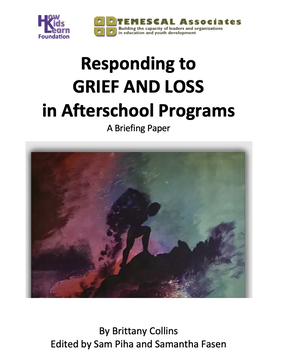
Responding to Grief and Loss in Afterschool Programs
There is a growing awareness of the importance of emotional regulation, social emotional learning, trauma informed practice and healing centered engagement, yet rarely is grief included in the conversation. It is important that we understand more about the needs of youth who are grieving. The purpose of this paper is to provide an overview for afterschool leaders on the issues of grief and loss experienced by young people, grief-responsive teaching, and related program strategies.
VIEW AND DOWNLOAD HERE.
TO PURCHASE SPIRAL-BOUND HARD COPIES OF THE GUIDE, PLEASE CONTACT US.
There is a growing awareness of the importance of emotional regulation, social emotional learning, trauma informed practice and healing centered engagement, yet rarely is grief included in the conversation. It is important that we understand more about the needs of youth who are grieving. The purpose of this paper is to provide an overview for afterschool leaders on the issues of grief and loss experienced by young people, grief-responsive teaching, and related program strategies.
VIEW AND DOWNLOAD HERE.
TO PURCHASE SPIRAL-BOUND HARD COPIES OF THE GUIDE, PLEASE CONTACT US.
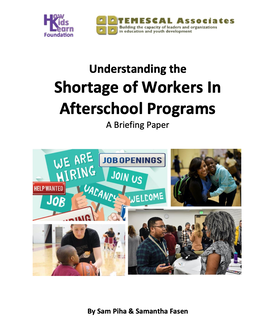
Understanding the Shortage of Workers in Afterschool Programs
Recruiting, hiring, and retaining afterschool workers have been longstanding issues. Then the COVID-19 pandemic hit—and these issues were greatly exacerbated. They had resulted in programs closing, drastically reducing capacity, and adding stress to afterschool workers. Many of these challenges are not unique to the afterschool field- they are being experienced by those in education and a wide range of fields.
We felt it is important to summarize this issue and share what we know in the time of COVID-19. In this paper, we examine the reasons for the current worker shortage, the impact of the COVID-19 pandemic, equity issues, and what we can do now.
VIEW AND DOWNLOAD HERE.
TO PURCHASE SPIRAL-BOUND HARD COPIES OF THE GUIDE, PLEASE CONTACT US.
Recruiting, hiring, and retaining afterschool workers have been longstanding issues. Then the COVID-19 pandemic hit—and these issues were greatly exacerbated. They had resulted in programs closing, drastically reducing capacity, and adding stress to afterschool workers. Many of these challenges are not unique to the afterschool field- they are being experienced by those in education and a wide range of fields.
We felt it is important to summarize this issue and share what we know in the time of COVID-19. In this paper, we examine the reasons for the current worker shortage, the impact of the COVID-19 pandemic, equity issues, and what we can do now.
VIEW AND DOWNLOAD HERE.
TO PURCHASE SPIRAL-BOUND HARD COPIES OF THE GUIDE, PLEASE CONTACT US.
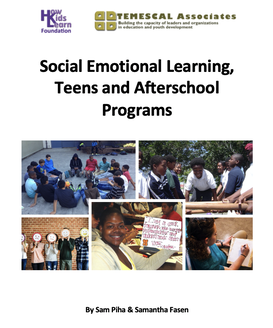
Social Emotional Learning, Teens and Afterschool Programs
We know from research that social emotional learning (SEL) is vital for young people’s healthy development. We also know that out-of-school and afterschool youth programs are excellent settings to promote the SEL skills of older youth. We’ve seen that programs focused on SEL skills are better with younger children but for older youth, ages 13-18, this is more complex.
The purpose of this paper is to inform and encourage afterschool programs to think more deeply about the SEL needs of older youth and how they can best offer youth opportunities to build their SEL skills. This paper also includes a discussion of the impact of the COVID-19 pandemic and examines how the SEL framework fits within other important youth program frameworks.
VIEW AND DOWNLOAD HERE.
TO PURCHASE SPIRAL-BOUND HARD COPIES OF THE GUIDE, PLEASE CONTACT US.
We know from research that social emotional learning (SEL) is vital for young people’s healthy development. We also know that out-of-school and afterschool youth programs are excellent settings to promote the SEL skills of older youth. We’ve seen that programs focused on SEL skills are better with younger children but for older youth, ages 13-18, this is more complex.
The purpose of this paper is to inform and encourage afterschool programs to think more deeply about the SEL needs of older youth and how they can best offer youth opportunities to build their SEL skills. This paper also includes a discussion of the impact of the COVID-19 pandemic and examines how the SEL framework fits within other important youth program frameworks.
VIEW AND DOWNLOAD HERE.
TO PURCHASE SPIRAL-BOUND HARD COPIES OF THE GUIDE, PLEASE CONTACT US.
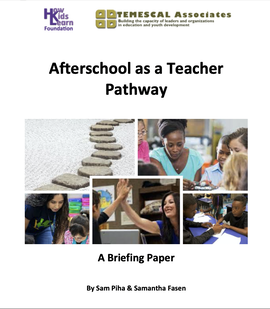
Afterschool as a Teacher Pathway
Our national teacher shortage predated COVID-19, however there is growing evidence that suggests that the shortage of educators will grow in coming years due to the pandemic. We also know that families of color were disproportionately affected by COVID-19. This will only exacerbate the shortage of teachers of color. Afterschool/ out of school time (OST)/ expanded learning programs (ELP) can be part of the solution. There are many reasons to think about OST as a teacher pathway.
The purpose of this paper is to inform and encourage expanded learning programs to develop afterschool to teacher pathways.
VIEW AND DOWNLOAD HERE.
TO PURCHASE SPIRAL-BOUND HARD COPIES OF THE GUIDE, PLEASE CONTACT US.
Our national teacher shortage predated COVID-19, however there is growing evidence that suggests that the shortage of educators will grow in coming years due to the pandemic. We also know that families of color were disproportionately affected by COVID-19. This will only exacerbate the shortage of teachers of color. Afterschool/ out of school time (OST)/ expanded learning programs (ELP) can be part of the solution. There are many reasons to think about OST as a teacher pathway.
The purpose of this paper is to inform and encourage expanded learning programs to develop afterschool to teacher pathways.
VIEW AND DOWNLOAD HERE.
TO PURCHASE SPIRAL-BOUND HARD COPIES OF THE GUIDE, PLEASE CONTACT US.
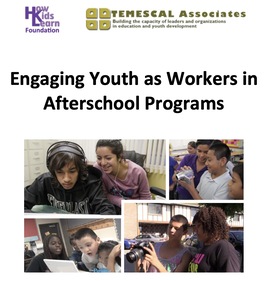
Engaging Youth as Workers in Afterschool Programs
We know that involving older youth as workers within afterschool programs makes a great deal of sense. Engaging youth in this way helps them address their developmental tasks and personal interests.
It offers experiences that build workforce and career skills, offers important leadership roles and opportunities for service, creates career pathways to professions such as teaching and social work, and ensures the program is more relevant to other youth.
The purpose of this paper is to inform and encourage expanded learning programs to engage youth as workers in these programs.
VIEW AND DOWNLOAD HERE.
TO PURCHASE SPIRAL-BOUND HARD COPIES OF THE GUIDE, PLEASE CONTACT US.
We know that involving older youth as workers within afterschool programs makes a great deal of sense. Engaging youth in this way helps them address their developmental tasks and personal interests.
It offers experiences that build workforce and career skills, offers important leadership roles and opportunities for service, creates career pathways to professions such as teaching and social work, and ensures the program is more relevant to other youth.
The purpose of this paper is to inform and encourage expanded learning programs to engage youth as workers in these programs.
VIEW AND DOWNLOAD HERE.
TO PURCHASE SPIRAL-BOUND HARD COPIES OF THE GUIDE, PLEASE CONTACT US.
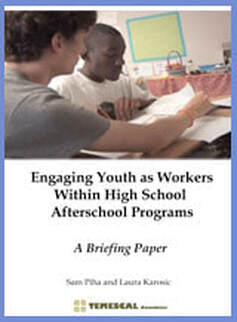
Engaging Youth as Workers Within High School Afterschool Programs: A Briefing Paper
Many 21st Century Community Learning Center (CCLC) high school afterschool programs in California strive to engage high school age youth as responsible workers and helpers within the program. However, because afterschool programs for older youth are relatively new, there is confusion in the field regarding the use of 21st CCLC funds for youth employment and compensation and there is a lack of knowledge about practices which have found to be effective. The purpose of this paper is to clarify guidelines regarding the employment of youth and to share strategies that are currently being used by After School Safety and Enrichment for Teens (ASSETs) programs to engage high school age youth through work within their afterschool programs.
VIEW AND DOWNLOAD HERE.
TO PURCHASE SPIRAL-BOUND HARD COPIES OF THE GUIDE, PLEASE CONTACT US.
Many 21st Century Community Learning Center (CCLC) high school afterschool programs in California strive to engage high school age youth as responsible workers and helpers within the program. However, because afterschool programs for older youth are relatively new, there is confusion in the field regarding the use of 21st CCLC funds for youth employment and compensation and there is a lack of knowledge about practices which have found to be effective. The purpose of this paper is to clarify guidelines regarding the employment of youth and to share strategies that are currently being used by After School Safety and Enrichment for Teens (ASSETs) programs to engage high school age youth through work within their afterschool programs.
VIEW AND DOWNLOAD HERE.
TO PURCHASE SPIRAL-BOUND HARD COPIES OF THE GUIDE, PLEASE CONTACT US.
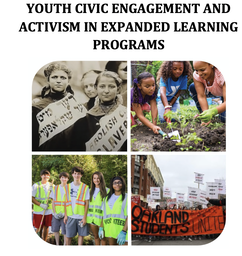
Youth Civic Engagement and Activism in Expanded Learning Programs
According to the Afterschool Alliance, “The afterschool field is an essential partner in ensuring that all children have the ability to participate in immersive, relevant, and hands-on civic engagement opportunities.”
The purpose of this paper is to inform and encourage expanded learning programs to offer youth opportunities to be civically engaged. Civic engagement strategies are participatory strategies and contribute to the positive development of youth and our democracy. There are already many program resources on the topic, some of which are detailed in the end notes. Thus, we are not looking to “reinvent the wheel”. Rather, it is our intention to capture and share valuable and intriguing ideas. Start today infusing civic engagement and activism in your afterschool curriculum and settings.
VIEW AND DOWNLOAD HERE.
TO PURCHASE SPIRAL-BOUND HARD COPIES OF THE GUIDE, PLEASE CONTACT US.
According to the Afterschool Alliance, “The afterschool field is an essential partner in ensuring that all children have the ability to participate in immersive, relevant, and hands-on civic engagement opportunities.”
The purpose of this paper is to inform and encourage expanded learning programs to offer youth opportunities to be civically engaged. Civic engagement strategies are participatory strategies and contribute to the positive development of youth and our democracy. There are already many program resources on the topic, some of which are detailed in the end notes. Thus, we are not looking to “reinvent the wheel”. Rather, it is our intention to capture and share valuable and intriguing ideas. Start today infusing civic engagement and activism in your afterschool curriculum and settings.
VIEW AND DOWNLOAD HERE.
TO PURCHASE SPIRAL-BOUND HARD COPIES OF THE GUIDE, PLEASE CONTACT US.
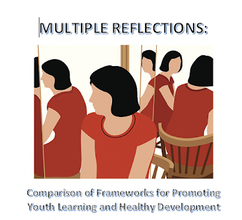
Multiple Reflections: Comparison of Frameworks for Promoting Youth Learning and Healthy Development
The purpose of this paper is to compare recent frameworks and note their commonalities. This paper offers a summary or overview of many of these frameworks as well as resources to learn more. It also provides a Crosswalk Chart to learn where their critical features overlap.
VIEW AND DOWNLOAD HERE.
TO PURCHASE SPIRAL-BOUND HARD COPIES OF THE GUIDE, PLEASE CONTACT US.
The purpose of this paper is to compare recent frameworks and note their commonalities. This paper offers a summary or overview of many of these frameworks as well as resources to learn more. It also provides a Crosswalk Chart to learn where their critical features overlap.
VIEW AND DOWNLOAD HERE.
TO PURCHASE SPIRAL-BOUND HARD COPIES OF THE GUIDE, PLEASE CONTACT US.
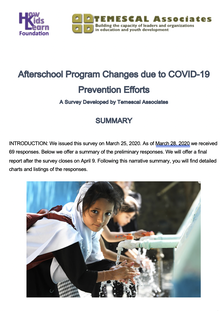
Preliminary Survey Results: Afterschool Program Changes due to COVID-19 Prevention Efforts
We issued this survey on March 25, 2020. As of March 28th, we received 69 responses. We have compiled a summary of the preliminary responses. We will offer a final report after the survey closes on April 9. Following the narrative summary, you will find detailed charts and listings of the responses.
VIEW AND DOWNLOAD HERE.
TO PURCHASE SPIRAL-BOUND HARD COPIES OF THE GUIDE, PLEASE CONTACT US.
We issued this survey on March 25, 2020. As of March 28th, we received 69 responses. We have compiled a summary of the preliminary responses. We will offer a final report after the survey closes on April 9. Following the narrative summary, you will find detailed charts and listings of the responses.
VIEW AND DOWNLOAD HERE.
TO PURCHASE SPIRAL-BOUND HARD COPIES OF THE GUIDE, PLEASE CONTACT US.
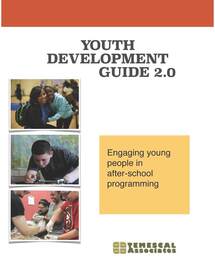
Youth Development Guide 2.0: Engaging Young People in After-School Programming
This Guide is designed to offer an introduction to youth development principles and practices to the diverse group of people involved in creating and implementing afterschool programs—program directors, school administrators, teachers, staff, volunteers, community partners, and others. We believe that adopting a youth development approach when designing and implementing afterschool programs can help ensure that young people get the most out of these programs.
VIEW AND DOWNLOAD HERE.
TO PURCHASE SPIRAL-BOUND HARD COPIES OF THE GUIDE, PLEASE CONTACT US.
This Guide is designed to offer an introduction to youth development principles and practices to the diverse group of people involved in creating and implementing afterschool programs—program directors, school administrators, teachers, staff, volunteers, community partners, and others. We believe that adopting a youth development approach when designing and implementing afterschool programs can help ensure that young people get the most out of these programs.
VIEW AND DOWNLOAD HERE.
TO PURCHASE SPIRAL-BOUND HARD COPIES OF THE GUIDE, PLEASE CONTACT US.
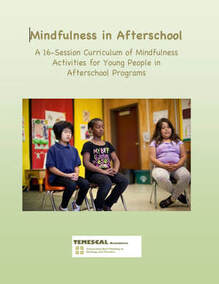
Mindfulness in Afterschool
Mindfulness training for young people has been successfully used by schools across the country to help young people during the school day. These mindfulness sessions (20-25 minutes) have helped young people better pay attention in the classroom, control their impulses and anger, reduce their stress levels, and create a healthier school community. Our belief is that extending mindfulness to the afterschool setting will have similar results. This 16-session curriculum is designed to accompany the Mindfulness in Afterschool training offered by Temescal Associates. The number of sessions conducted each week (1 or 2 per week) is the decision of the program leader.
VIEW AND DOWNLOAD HERE.
TO PURCHASE SPIRAL-BOUND HARD COPIES OF THE GUIDE, PLEASE CONTACT US.
Mindfulness training for young people has been successfully used by schools across the country to help young people during the school day. These mindfulness sessions (20-25 minutes) have helped young people better pay attention in the classroom, control their impulses and anger, reduce their stress levels, and create a healthier school community. Our belief is that extending mindfulness to the afterschool setting will have similar results. This 16-session curriculum is designed to accompany the Mindfulness in Afterschool training offered by Temescal Associates. The number of sessions conducted each week (1 or 2 per week) is the decision of the program leader.
VIEW AND DOWNLOAD HERE.
TO PURCHASE SPIRAL-BOUND HARD COPIES OF THE GUIDE, PLEASE CONTACT US.

YOUTH WORK FUNDAMENTALS: BUILDING A POSITIVE PROGRAM CLIMATE
Have you ever walked onto a school campus or into an afterschool program where there's joy, acceptance, consideration, and kindness? It's in the air. It is felt. Where listening to different people’s points of view is the norm? Where support and encouragement is commonly shared? Where authentic human connection is acknowledged and felt? These foundational elements of a positive program climate lay the nurturing soil from which the seeds of impassioned teaching and learning in afterschool programs sprout.
VIEW AND DOWNLOAD HERE.
Have you ever walked onto a school campus or into an afterschool program where there's joy, acceptance, consideration, and kindness? It's in the air. It is felt. Where listening to different people’s points of view is the norm? Where support and encouragement is commonly shared? Where authentic human connection is acknowledged and felt? These foundational elements of a positive program climate lay the nurturing soil from which the seeds of impassioned teaching and learning in afterschool programs sprout.
VIEW AND DOWNLOAD HERE.
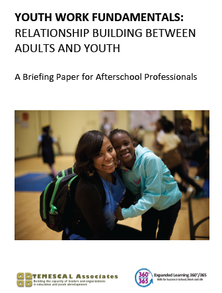
YOUTH WORK FUNDAMENTALS: RELATIONSHIP BUILDING BETWEEN ADULTS AND YOUTH
For many years, there has been a drive to improve the quality of afterschool programs and with it has come the expansion of literature, research, and tools to help aid afterschool leaders on their road to improvement. However, as decades of research and experience has shown, there are a few fundamentals of quality youth work that are unchanged over time. This briefing paper focuses on one youth work fundamental: relationship building between adults and youth.
VIEW AND DOWNLOAD HERE.
For many years, there has been a drive to improve the quality of afterschool programs and with it has come the expansion of literature, research, and tools to help aid afterschool leaders on their road to improvement. However, as decades of research and experience has shown, there are a few fundamentals of quality youth work that are unchanged over time. This briefing paper focuses on one youth work fundamental: relationship building between adults and youth.
VIEW AND DOWNLOAD HERE.
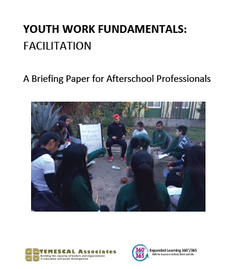
YOUTH WORK FUNDAMENTALS: FACILITATION
For many years, there has been a drive to improve the quality of afterschool programs and with it has come the expansion of literature, research, and tools to help aid afterschool leaders on their road to improvement. However, as decades of research and experience has shown, there are a few fundamentals of quality youth work that are unchanged over time. This briefing paper focuses on one youth work fundamental: the art of facilitation.
VIEW AND DOWNLOAD HERE.
For many years, there has been a drive to improve the quality of afterschool programs and with it has come the expansion of literature, research, and tools to help aid afterschool leaders on their road to improvement. However, as decades of research and experience has shown, there are a few fundamentals of quality youth work that are unchanged over time. This briefing paper focuses on one youth work fundamental: the art of facilitation.
VIEW AND DOWNLOAD HERE.
A FACILITATION CASE STUDY
We offer a brief facilitation case study regarding a request to assist a school in developing a conflict resolution program. Stacey Daraio facilitated meetings with classroom teachers and youth. We hope that this case study illustrates some of the facilitation practices discussed in Youth Work Fundamentals: Facilitation, A Briefing Paper For Afterschool Professionals (above).
VIEW AND DOWNLOAD HERE.
We offer a brief facilitation case study regarding a request to assist a school in developing a conflict resolution program. Stacey Daraio facilitated meetings with classroom teachers and youth. We hope that this case study illustrates some of the facilitation practices discussed in Youth Work Fundamentals: Facilitation, A Briefing Paper For Afterschool Professionals (above).
VIEW AND DOWNLOAD HERE.
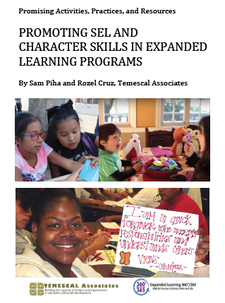
PROMOTING SEL AND CHARACTER SKILLS IN EXPANDED LEARNING PROGRAMS
There is now a strong consensus that young people need more than reading and writing skills if they are to be successful in school, work, and life.
This paper provides an overview of social emotional and character building skills. It goes on to provide examples of activities and practices for expanded learning programs provided for, and by, Expanded Learning Programs and Technical Assistance organizations. To identify expanded learning practices and activities, we reached out to organizations across California.
VIEW AND DOWNLOAD HERE.
TO PURCHASE SPIRAL-BOUND HARD COPIES OF THE GUIDE, PLEASE CONTACT US.
There is now a strong consensus that young people need more than reading and writing skills if they are to be successful in school, work, and life.
This paper provides an overview of social emotional and character building skills. It goes on to provide examples of activities and practices for expanded learning programs provided for, and by, Expanded Learning Programs and Technical Assistance organizations. To identify expanded learning practices and activities, we reached out to organizations across California.
VIEW AND DOWNLOAD HERE.
TO PURCHASE SPIRAL-BOUND HARD COPIES OF THE GUIDE, PLEASE CONTACT US.
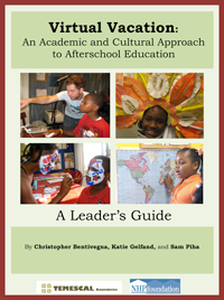
The Virtual Vacation Leader's Guide
This guide was written as a resource for those who oversee, develop, and implement afterschool programs. It features a structured approach that combines academics, culture, and creativity. Virtual Vacation is particularly well-suited to elementary age children, but can be adapted for older youth. The Virtual Vacation approach was developed by afterschool leaders who operate afterschool programs within affordable housing settings for the NHP Foundation. This guide was developed by Temescal Associates and NHP staff. Temescal also offers training on its use.
For those of you interested in incorporating Virtual Vacation into your afterschool programs, we encourage you to begin by reading the description and benefits of the Virtual Vacation approach (Chapter 1). You will want to carefully review the Virtual Vacation components (Chapter 2) and then the Virtual Vacation examples (Chapter 5). These activity examples can serve as a curriculum to guide your first Virtual Vacation. We encourage you to use the Virtual Vacation examples before embarking on new destinations and before creating your own Virtual Vacation.
The section entitled "Getting Started" (Chapter 3) walks you through the steps that are needed for effective implementation. The Virtual Vacation planning templates (Chapter 4) will be useful for planning and documenting the course of your Virtual Vacation. Regardless of whether you use one of the enclosed examples or create your own Virtual Vacation, be sure to pay attention to helpful hints given throughout as well as the resources provided at the end of the leader's guide.
VIEW AND DOWNLOAD HERE.
TO PURCHASE SPIRAL-BOUND HARD COPIES OF THE GUIDE, PLEASE CONTACT US.
This guide was written as a resource for those who oversee, develop, and implement afterschool programs. It features a structured approach that combines academics, culture, and creativity. Virtual Vacation is particularly well-suited to elementary age children, but can be adapted for older youth. The Virtual Vacation approach was developed by afterschool leaders who operate afterschool programs within affordable housing settings for the NHP Foundation. This guide was developed by Temescal Associates and NHP staff. Temescal also offers training on its use.
For those of you interested in incorporating Virtual Vacation into your afterschool programs, we encourage you to begin by reading the description and benefits of the Virtual Vacation approach (Chapter 1). You will want to carefully review the Virtual Vacation components (Chapter 2) and then the Virtual Vacation examples (Chapter 5). These activity examples can serve as a curriculum to guide your first Virtual Vacation. We encourage you to use the Virtual Vacation examples before embarking on new destinations and before creating your own Virtual Vacation.
The section entitled "Getting Started" (Chapter 3) walks you through the steps that are needed for effective implementation. The Virtual Vacation planning templates (Chapter 4) will be useful for planning and documenting the course of your Virtual Vacation. Regardless of whether you use one of the enclosed examples or create your own Virtual Vacation, be sure to pay attention to helpful hints given throughout as well as the resources provided at the end of the leader's guide.
VIEW AND DOWNLOAD HERE.
TO PURCHASE SPIRAL-BOUND HARD COPIES OF THE GUIDE, PLEASE CONTACT US.

After School and Beyond: A Profile of Hope Through Housing Foundation's Youth Development Program
by Sam Piha, Temescal Associates. Hope Through Housing Foundation (HOPE) was established in 1998 to further the mission of community revitalization envisioned by its partner organization, National Community Renaissance (National CORE), a national nonprofit developer of affordable housing.
VIEW AND DOWNLOAD HERE.
by Sam Piha, Temescal Associates. Hope Through Housing Foundation (HOPE) was established in 1998 to further the mission of community revitalization envisioned by its partner organization, National Community Renaissance (National CORE), a national nonprofit developer of affordable housing.
VIEW AND DOWNLOAD HERE.

Afterschool Programs in Affordable Housing Communities
by Sam Piha, Temescal Associates. A Growing number of families with school age children reside in affordable housing settings. Many of these intentional communities have access to afterschool programs provided by resident service organizations. Housing-based afterschool programs for children and youth represent the third place for afterschool programs, following those that are operated within public schools and the community.
VIEW AND DOWNLOAD HERE.
by Sam Piha, Temescal Associates. A Growing number of families with school age children reside in affordable housing settings. Many of these intentional communities have access to afterschool programs provided by resident service organizations. Housing-based afterschool programs for children and youth represent the third place for afterschool programs, following those that are operated within public schools and the community.
VIEW AND DOWNLOAD HERE.
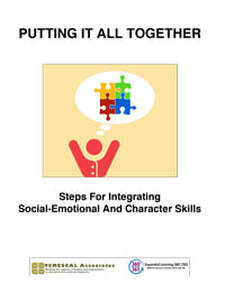
PUTTING IT ALL TOGETHER: STEPS FOR INTEGRATING SOCIAL-EMOTIONAL AND CHARACTER SKILLS
All children and youth need social-emotional and character skills in order to thrive in school, work, and life. (By “skills”, we are referring to actual skills as well as attitudes and beliefs.) A broad body of research substantiates that academic ability works in tandem with social-emotional and character skills. We want our youth, as they reach adulthood, to be well prepared for productive careers and as socially conscious, engaged citizens.
Through their design and structure, high-quality expanded learning programs provide valuable opportunities for children and youth to develop social-emotional and character skills. (By programs, we are referring to both the youth program staff as well as the larger parent organization.) These skills are both “taught” (through program structures and activities) and “caught” (by exposing youth to the program culture and the modeling/behavior of program staff). This document suggests a number of intentional steps to promote these skills in expanded learning programs. It is important to note that promoting these skills is an important part of promoting a quality program.
VIEW AND DOWNLOAD HERE.
All children and youth need social-emotional and character skills in order to thrive in school, work, and life. (By “skills”, we are referring to actual skills as well as attitudes and beliefs.) A broad body of research substantiates that academic ability works in tandem with social-emotional and character skills. We want our youth, as they reach adulthood, to be well prepared for productive careers and as socially conscious, engaged citizens.
Through their design and structure, high-quality expanded learning programs provide valuable opportunities for children and youth to develop social-emotional and character skills. (By programs, we are referring to both the youth program staff as well as the larger parent organization.) These skills are both “taught” (through program structures and activities) and “caught” (by exposing youth to the program culture and the modeling/behavior of program staff). This document suggests a number of intentional steps to promote these skills in expanded learning programs. It is important to note that promoting these skills is an important part of promoting a quality program.
VIEW AND DOWNLOAD HERE.
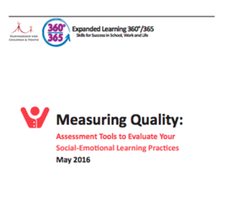
MEASURING QUALITY: ASSESSMENT TOOLS TO EVALUATE YOUR SOCIAL-EMOTIONAL LEARNING PRACTICES
This guide is designed to help school districts and their partner organizations identify tools to assess the quality of their practices in relation to social-emotional learning (SEL). We’ve reviewed ten commonly available program quality assessment tools, aligned with the five quality standards identified by the Expanded Learning 360º/365 initiative as critical practice areas for SEL. The practice areas are: safe and supportive environment; active and engaged learning; skill building; youth voice and leadership; and diversity, access, and equity.
VIEW AND DOWNLOAD HERE.
This guide is designed to help school districts and their partner organizations identify tools to assess the quality of their practices in relation to social-emotional learning (SEL). We’ve reviewed ten commonly available program quality assessment tools, aligned with the five quality standards identified by the Expanded Learning 360º/365 initiative as critical practice areas for SEL. The practice areas are: safe and supportive environment; active and engaged learning; skill building; youth voice and leadership; and diversity, access, and equity.
VIEW AND DOWNLOAD HERE.
|
|
Beyond Expectations - The Power of High School Afterschool
Watch a video of high school youth and leaders in the field explain the importance and power of afterschool programming and the role it has played in their lives. Created in conjunction with the youth of the YMCA of Greater Long Beach and Change Agent Productions, a youth-run multimedia program. This video was made possible with generous support from the William T. Grant Foundation. TO PURCHASE DVD COPIES OF THIS VIDEO, PLEASE CONTACT US. |

Getting the Most from Afterschool: The Role of Afterschool Programs in a High-Stakes Learning Environment
This paper offers a review of the unique opportunities offered by afterschool programs that includes but goes well beyond providing academic supports.
VIEW AND DOWNLOAD HERE.
This paper offers a review of the unique opportunities offered by afterschool programs that includes but goes well beyond providing academic supports.
VIEW AND DOWNLOAD HERE.
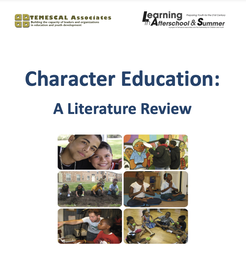
Character Education: A Literature Review
This literature review defines character education and the major categories it falls into as well as discuss best practices and examples of current programs.
VIEW AND DOWNLOAD HERE.
This literature review defines character education and the major categories it falls into as well as discuss best practices and examples of current programs.
VIEW AND DOWNLOAD HERE.
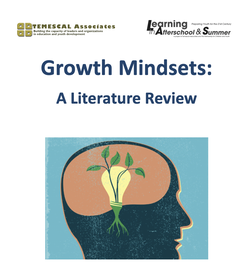
Growth Mindsets: A Literature Review
In this document, we discuss what the difference is between a fixed mindset and a growth mindset and how that affects one’s ability to learn and ultimately succeed.
VIEW AND DOWNLOAD HERE.
In this document, we discuss what the difference is between a fixed mindset and a growth mindset and how that affects one’s ability to learn and ultimately succeed.
VIEW AND DOWNLOAD HERE.
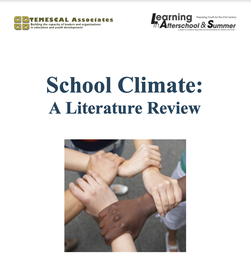
School Climate: A Literature Review
For many years, educators have recognized the importance of school climate. However, it was not until the 1950s that educators and researchers began to study school climate and create assessment tools to help assist schools in achieving positive school climate.
VIEW AND DOWNLOAD HERE.
For many years, educators have recognized the importance of school climate. However, it was not until the 1950s that educators and researchers began to study school climate and create assessment tools to help assist schools in achieving positive school climate.
VIEW AND DOWNLOAD HERE.



